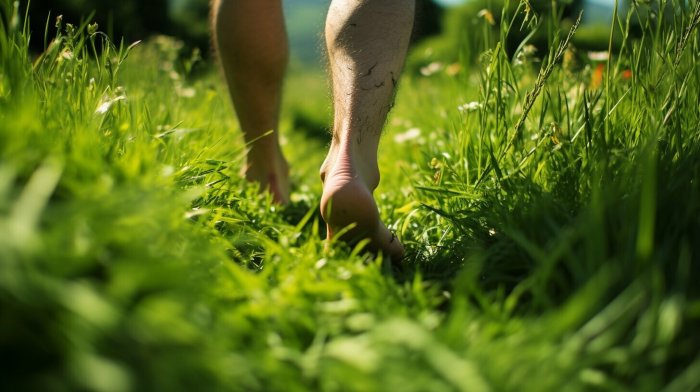Why don’t hobbits wear shoes? This intriguing question sets the stage for an enthralling narrative, offering readers a glimpse into a story that is rich in detail and brimming with originality from the outset.
Hobbits, the beloved inhabitants of Middle-earth, are known for their unique physical characteristics, cultural norms, and practical considerations that have shaped their distinctive footwear choices. Delve into this captivating exploration as we uncover the reasons behind their bare feet.
Hobbit’s Feet

Hobbits possess unique physical characteristics that set them apart from humans, one of the most notable being their feet. Hobbit feet are significantly larger and hairier than human feet, with thick, leathery soles that make them highly resistant to wear and tear.
They also have long, strong toes that allow them to navigate uneven terrain with ease.
Evolutionary Adaptations
The distinctive features of hobbit feet are believed to have evolved over time as a result of their lifestyle and environment. Living in close proximity to nature, hobbits needed feet that could withstand the rigors of walking through dense forests and across rough terrain.
The large size of their feet provided stability and support, while the thick soles protected them from sharp objects and thorns. The hairy soles also helped to keep their feet warm in cold weather.
Cultural Influences
Hobbits’ cultural norms and traditions greatly influenced their footwear choices. They valued comfort and practicality above all else, which is reflected in their simple and durable clothing and footwear.
Community and Family
Hobbits placed great importance on community and family life. They lived in close-knit villages and often worked together in communal activities, such as farming and gardening. As a result, they preferred footwear that allowed them to move easily and comfortably within their communities.
Practical Considerations: Why Don’t Hobbits Wear Shoes
Hobbits’ choice to go barefoot offers several practical advantages. Their hairy feet provide ample protection from rough terrain, allowing them to navigate their natural environment with ease. The lack of footwear enhances their agility and balance, facilitating their nimble movements and quick reflexes.
Lifestyle and Environment
Hobbits’ lifestyle revolves around close contact with nature. Their homes are typically nestled amidst rolling hills and lush forests, where they engage in farming, gardening, and other outdoor activities. Going barefoot allows them to connect deeply with their surroundings, feeling the textures of the earth and responding swiftly to changes in the terrain.
Beneficial Situations
- Stealthy Movement:Barefoot hobbits can move silently through undergrowth, making them adept at hunting and tracking prey without alerting their quarry.
- Agility in Combat:Their nimble feet provide an advantage in combat, allowing them to dodge and weave swiftly, avoiding enemy attacks.
- Environmental Adaptation:Going barefoot enhances their sensory perception, enabling them to detect subtle changes in temperature, moisture, and terrain conditions.
Social Significance

In hobbit culture, going barefoot holds profound social implications. It signifies a deep connection to the earth, a sense of freedom, and a rejection of societal constraints.
Barefoot Identity
Hobbits who choose to go barefoot often identify themselves as being more in tune with nature and the simple life. They value comfort and practicality over fashion and status.
Perception of Outsiders
Hobbits generally view those who wear shoes as being more formal and distant. They may be seen as outsiders or even pretentious, especially if they come from a culture that values elaborate footwear.
Exceptions to the Rule

While the general rule is that hobbits do not wear shoes, there are a few exceptions to this norm.
One exception is when hobbits are traveling long distances. In these cases, they may wear simple leather boots or sandals to protect their feet from the elements and rough terrain.
Hobbits are known for their hairy feet, which they proudly display by going barefoot. This may seem strange to some, but there are several reasons why hobbits prefer to go shoeless. Their feet are naturally tough and resistant to injury, and they have a strong sense of balance and coordination.
Additionally, their feet are very sensitive, which allows them to feel the ground beneath them and navigate their surroundings with ease. Interestingly, Macbeth’s fatal flaw was his ambition, which led him to commit heinous crimes in order to gain power.
Unlike Macbeth, hobbits are content with their simple lives and have no desire for power or material possessions. They value community and friendship above all else, and they are known for their kind and generous nature.
Frodo Baggins
Another exception is when hobbits are performing certain tasks that require foot protection. For example, when working in the garden or forge, hobbits may wear gloves or boots to protect their hands and feet from dirt, heat, or sharp objects.
Finally, some hobbits simply prefer to wear shoes, even if it is not the traditional hobbit custom. These hobbits may enjoy the comfort, style, or protection that shoes provide.
Literary Depictions
J.R.R. Tolkien’s portrayal of hobbits’ footwear in his works, particularly in the Lord of the Rings series, is consistent and well-defined. Hobbits are depicted as typically barefoot or wearing simple, leather boots or shoes.
This portrayal aligns with the rustic and nature-loving nature of hobbits. Their connection to the land and their preference for comfort and practicality are reflected in their footwear choices.
Consistency and Evolution
Throughout the Lord of the Rings series, Tolkien maintains consistency in his depiction of hobbits’ footwear. From the initial chapters in the Shire to the epic battles in Middle-earth, hobbits are consistently portrayed as barefoot or wearing simple, practical footwear.
However, there are subtle evolutions in Tolkien’s portrayal as the story progresses. As the hobbits journey further from home and encounter new cultures, their footwear choices sometimes reflect their experiences.
Specific Passages and Scenes
In the opening chapters of The Fellowship of the Ring, Frodo Baggins is described as “going barefoot, except in winter, when he wore boots of leather.”
Later in the story, as the hobbits travel through the Misty Mountains, they encounter snow and cold weather. Tolkien describes them as “wearing boots of fur and leather.”
These examples illustrate the consistency and evolution of Tolkien’s portrayal of hobbits’ footwear. Hobbits are typically barefoot or wear simple, practical footwear, but their choices may adapt to the environment or circumstances they encounter.
Artistic Interpretations

Hobbits have been depicted in various forms of media, including movies, illustrations, and other artistic interpretations. These interpretations often reflect the cultural and literary influences on hobbit lore.
Movie Depictions, Why don’t hobbits wear shoes
In Peter Jackson’s Lord of the Ringsfilm trilogy, hobbits are typically portrayed with bare feet. This portrayal aligns with the literary tradition, as hobbits are often described as being barefoot in Tolkien’s works.
Illustrations
Illustrations of hobbits vary in their depiction of footwear. Some illustrations show hobbits with bare feet, while others depict them wearing simple leather boots or sandals. These variations may reflect the artist’s interpretation of the hobbit’s lifestyle and environment.
Other Forms of Media
Hobbits have also been depicted in other forms of media, such as video games and merchandise. These depictions often draw inspiration from the literary and cinematic portrayals of hobbits, but may also incorporate unique elements.
Modern Adaptations
In contemporary culture, the concept of hobbits going barefoot has undergone adaptations to suit modern sensibilities and artistic interpretations.
Movies and TV Shows
In the “Lord of the Rings” film trilogy and “The Hobbit” film trilogy, hobbits are depicted without shoes, adhering to Tolkien’s original vision. This portrayal has solidified the image of hobbits as barefoot creatures in the minds of audiences worldwide.
Video Games
Video games such as “The Lord of the Rings: The Third Age” and “Middle-earth: Shadow of War” feature playable hobbit characters who go barefoot, immersing players in the lore and aesthetics of Tolkien’s world.
Reasons for Adaptations
These adaptations serve several purposes. They maintain the authenticity of Tolkien’s vision, enhance the visual distinctiveness of hobbits, and connect audiences with the earthy and grounded nature of these characters.
Impact on Perceptions
The consistent portrayal of hobbits without shoes in modern adaptations has reinforced the idea that hobbits are innately connected to nature and their surroundings. This has further popularized the image of hobbits as barefoot beings, solidifying their unique identity in modern culture.
FAQ Overview
Why do hobbits have hairy feet?
Hobbits’ hairy feet are an evolutionary adaptation that provides insulation, protection, and enhanced grip in their natural environment.
Do all hobbits go barefoot?
While most hobbits prefer to go barefoot, there are exceptions, such as those who live in colder climates or engage in specific activities that require footwear.
What does being barefoot symbolize in hobbit culture?
Bare feet are seen as a sign of humility, connection to nature, and a rejection of societal constraints within hobbit society.